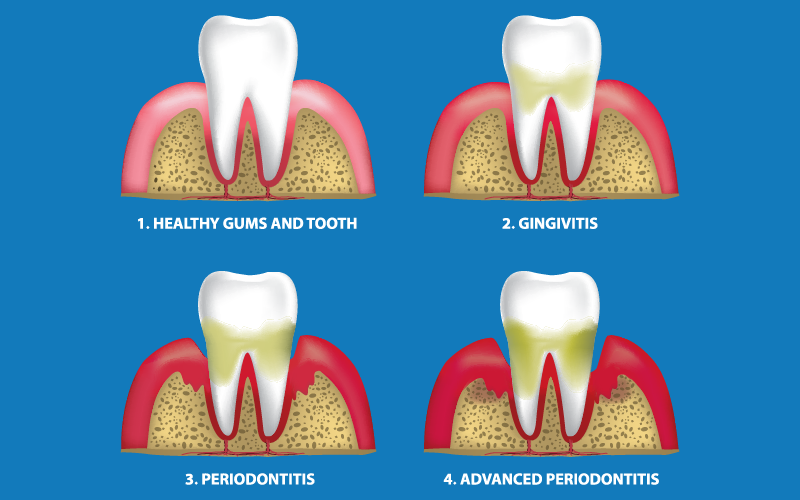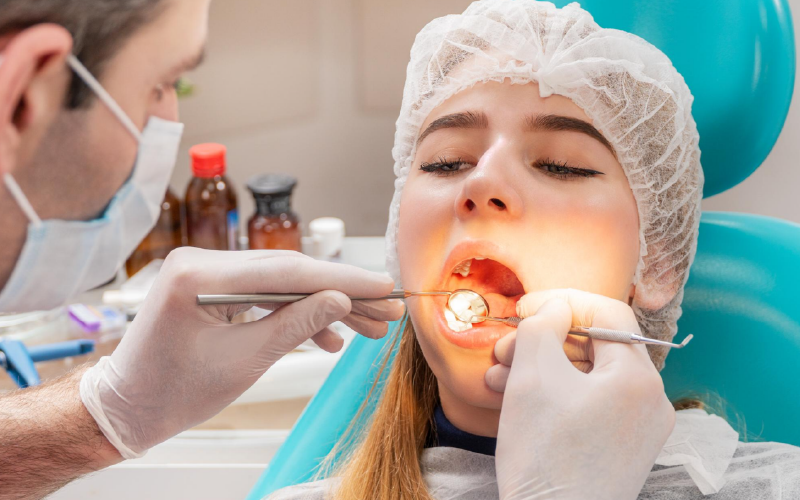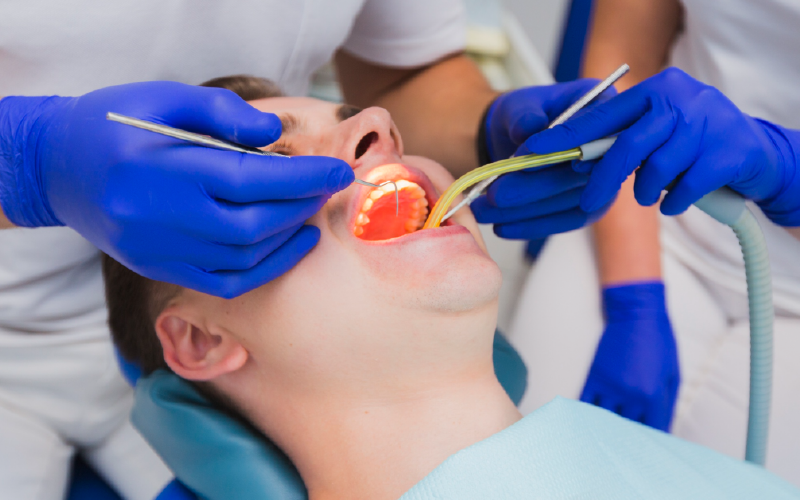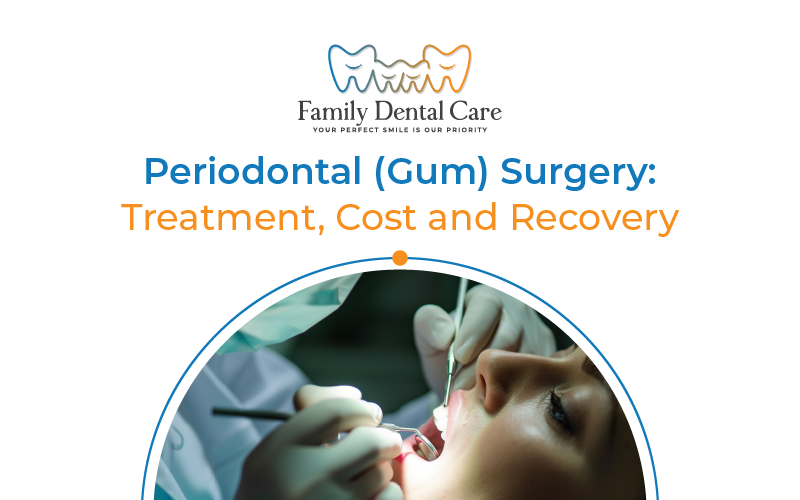Periodontal surgery is an essential medical procedure for individuals battling gum disease, a condition that affects a significant portion of the adult population worldwide.
It can be helpful to demystify what for many may be a frightening prospect by being aware of the subtleties of this treatment, from the initial periodontal cleaning to the minute intricacies of the surgery and the recuperation phase.
This comprehensive guide aims to shed light on periodontal surgery, covering the treatment, associated costs, and recovery, peppered with pertinent questions for easier understanding.
What is Periodontal Disease?

Periodontal disease, often known as gum disease, is marked by inflamed and infected gums. This serious condition not only jeopardizes the health of soft tissues within the mouth but can also escalate to the point where the bone anchoring the teeth is irreparably damaged.
Without timely and effective intervention, this progressive ailment has the potential to culminate in tooth loss, underscoring the importance of maintaining diligent oral hygiene practices and seeking regular dental care and professional dental assessments.
Symptoms of Gum Disease
The first step in receiving prompt treatment for gum disease is identifying its symptoms.
Here are some of the common gum disease symptoms–
– Swollen, red, or tender gums.
– Bleeding gums during brushing or flossing.
– Receding gums, makes the teeth look longer.
– Persistent foul taste or breath in the mouth.
When is Periodontal Surgery Needed?
Periodontal surgery comes into play when periodontal cleaning is insufficient to heal the gums. This might be due to the severity of the gum disease or the specific anatomy of the patient’s mouth.
Necessity of Periodontal Surgery-
1. When periodontal cleaning (scaling and root planing) fails to heal the gums adequately.
2. Due to the advanced stage of gum disease that can’t be managed by non-surgical treatments alone.
3. The unique anatomy of a patient’s mouth may require surgical intervention for effective treatment.
4. Persistent symptoms such as deep gum pockets or significant bone loss around teeth.
5. To prevent further damage and potential tooth loss by addressing the underlying issues directly.
Recovery from Gum Surgery

Recovery varies depending on the type of surgery performed and the individual’s overall health. Here are some general recovery tips-
1. Rest and follow the periodontist’s post-operative care instructions closely.
2. Eat soft, nutritious foods and avoid hot or spicy items that might irritate the gums.
3. Practice good oral hygiene, using a soft toothbrush and gentle brushing techniques.
Gum Disease Treatment Cost
The cost of gum disease treatment can vary widely depending on the extent of the disease and the type of treatment required.
Periodontal surgery can range from a few hundred to several thousand dollars. It’s important to consult with your dental insurance provider and the periodontal specialist to understand the coverage and out-of-pocket expenses.
Types of Periodontal Surgery
Several types of periodontal surgery may be recommended, depending on the nature and severity of the gum disease. These include-
– Flap Surgery
This procedure is pivotal for patients with considerable plaque buildup beneath the gums. By creating small incisions in the gum, a periodontist can lift back a section of gum tissue, exposing the roots for effective scaling and root planing.
Besides deep cleaning, flap surgery allows for the repair of bone damage, crucial in restoring the integrity of the gum and bone structure around the teeth. This method is often recommended when the pockets between gum and tooth are too deep for traditional cleaning.
– Gum Grafts
Gum grafting is an essential technique for addressing the issue of gum recession, where the gum tissue has worn away, exposing more of the tooth or its root.
By taking tissue from elsewhere in the mouth (often the palate) and attaching it to the affected area, gum grafts can cover exposed roots, significantly reducing tooth sensitivity and improving the aesthetic appearance of the smile.
This procedure also helps prevent further recession and bone loss, protecting against the risk of future tooth loss.
– Bone Grafting
Bone grafting is a surgical procedure designed to combat the effects of severe periodontal disease, which can lead to significant bone loss around the teeth.
By using grafting material, which can be sourced from the patient’s own body, a synthetic material, or donated bone, this procedure aims to promote the regeneration of lost bone tissue.
Restoring the lost bone is crucial not only for the stability and support of existing teeth but also as a preparatory step for future dental implants, ensuring there is sufficient bone structure for implant placement.
The Periodontal Surgery Procedure

The gum surgery procedure involves several steps, carefully executed by periodontal specialists. Under local anesthesia, the gum tissue is gently pulled back to allow for deep cleaning and bone repair.
In some cases, mesh-like material may be used to encourage bone and tissue growth.
1. Preparation and Anesthesia
The procedure commences with the administration of local anesthesia to ensure patient comfort throughout the surgery. This initial step is crucial for numbing the area around the affected gums and teeth, minimizing discomfort.
2. Incision and Flap Creation
The periodontist makes precise incisions along the gum line to create a flap. This flap of gum tissue is then gently pulled back to provide clear access to the roots of the teeth and the underlying bone structure, areas typically compromised by periodontal disease.
3. Deep Cleaning
With the roots exposed, the specialist conducts an extensive dental checkup and cleaning process, meticulously removing plaque and tartar buildup from the teeth and root surfaces. This step is vital for eliminating the bacterial infections that contribute to gum disease.
4. Bone Repair and Regeneration
In cases where the bone has been damaged by periodontal disease, the surgery may involve reshaping the bone around the teeth to eliminate craters and irregularities.
This smoothing process not only facilitates better healing but also prevents bacteria from accumulating in these spaces in the future.
5. Use of Regenerative Materials
To encourage the regrowth of bone and gum tissue, the periodontist may apply a mesh-like fabric between the bone and gum tissue.
This barrier prevents unwanted tissue from entering the bone area, allowing the bone and connective tissue to regenerate more effectively.
In some cases, grafting materials or tissue-stimulating proteins may also be used to foster tissue growth and bone regeneration.
6. Flap Repositioning and Suturing
Once the deep cleaning and bone repair are complete, the gum flap is carefully repositioned against the teeth.
Sutures are then used to hold the gum tissue in place during the healing process, ensuring that the gums heal snugly around the teeth.
7. Postoperative Care and Recovery
The final stage of the procedure involves providing the patient with detailed postoperative care instructions, ensuring they have everything they need to recover smoothly.
From guidance on oral hygiene practices to dietary recommendations, and even scheduling necessary follow-up appointments to monitor healing and remove sutures, our goal is to support your journey to improved oral health at every stage.
At our clinic, we pride ourselves on being your trusted dentist for all your dental needs, including attentive post-surgery care.
Throughout the entire periodontal surgery procedure, we prioritize your comfort and well-being, meticulously preserving and restoring the structural integrity of your gums, teeth, and bones.
Our focus is not just on treatment, but on ensuring your overall oral health and functionality are significantly improved.
Questions to Ask Your Periodontal Specialist
Before undergoing periodontal surgery, here are some questions you might consider asking-
1. What type of periodontal surgery do you recommend for my condition?
2. What can I expect during the recovery process?
3. How can I best prepare for surgery and recovery?
4. What are the costs involved, and what insurance coverage can I expect?
Conclusion
Grasping the intricacies of periodontal surgery, its financial implications, and the recuperation journey empowers patients to tackle their periodontal health with assurance.
The key to preserving your radiant smile and enhancing your overall well-being lies in the timely detection and management of gum disease. Embark on a path to a rejuvenated, joyful oral health regime by consulting with a periodontal specialist.
Ready to make a change? Reach out to a trusted dentist in Simi Valley today and take that crucial step toward a brighter, healthier smile.

